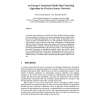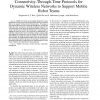1380 search results - page 225 / 276 » Mobility-capacity-delay trade-off in wireless ad hoc network... |
OPODIS
2010
13 years 5 months ago
2010
Abstract. Wireless Ad-hoc networks are distributed systems that often reside in error-prone environments. Self-stabilization lets the system recover autonomously from an arbitrary ...
GLOBECOM
2009
IEEE
13 years 5 months ago
2009
IEEE
Due to the limited energy supplies of nodes in many applications like wireless sensor networks, energy efficiency is crucial for extending the lifetime of these networks. This pape...
ICN
2005
Springer
14 years 1 months ago
2005
Springer
A wireless sensor network is a new kind of wireless Ad-Hoc network consisting of a large number of small low cost, power constrained sensors deployed in a large area for gathering...
ICRA
2003
IEEE
14 years 1 months ago
2003
IEEE
—Mobile robot teams are increasingly deployed in various applications involving remote operations in unstructured environments that do not support wireless network infrastructure...
IPPS
2005
IEEE
14 years 1 months ago
2005
IEEE
An important problem in wireless networks, such as wireless ad hoc and sensor networks, is to select a few nodes to form a virtual backbone that supports routing and other tasks s...


